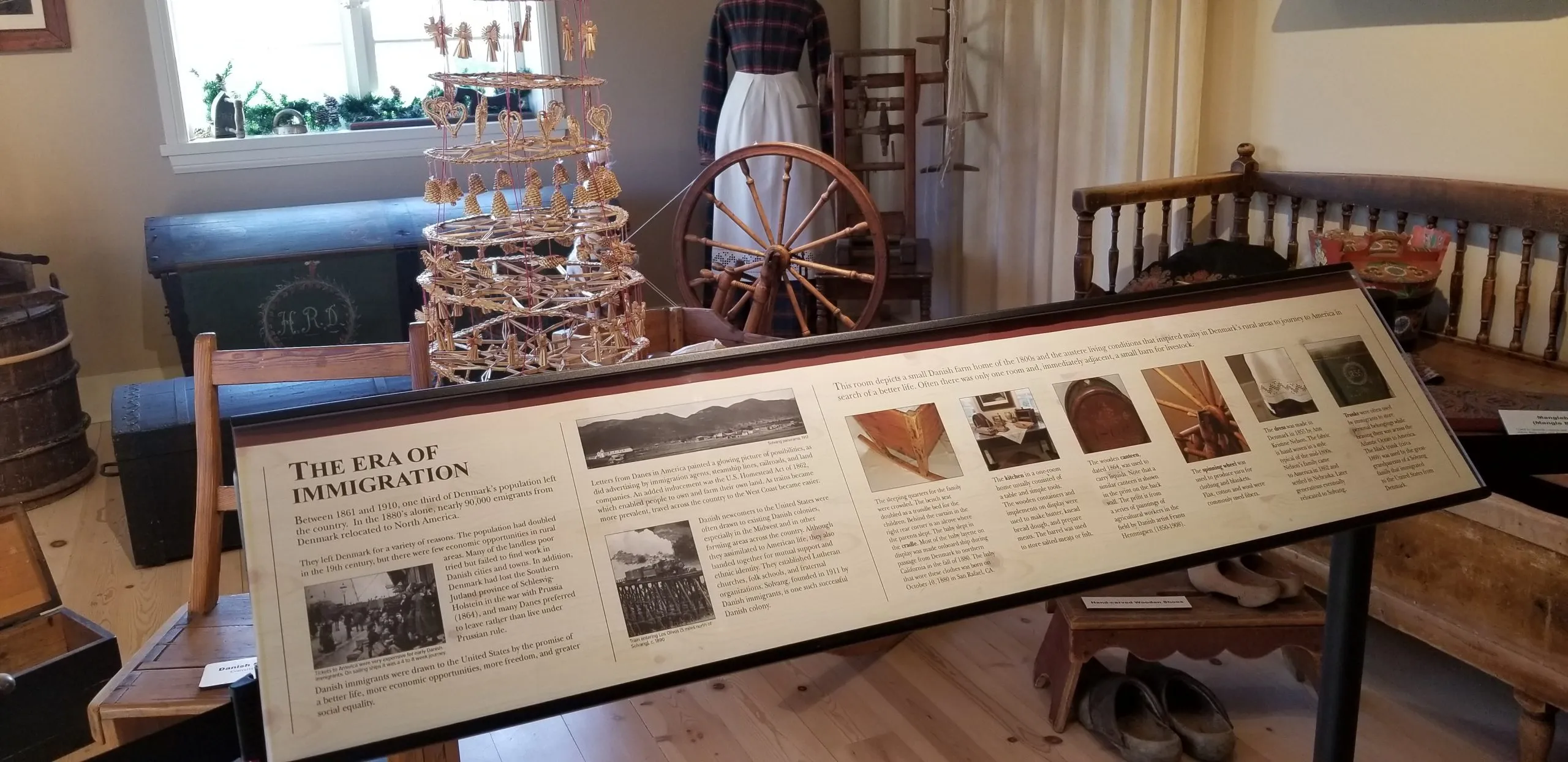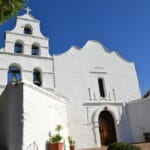Imagine stepping into a place where time seems to stand still, where the stories of yesterday blend seamlessly with the vibrant spirit of today. That’s the magic that awaits you at the Elverhøj Museum of History & Art in Solvang, California. More than just a museum, it’s a living testament to Danish heritage, a testament carefully woven into the very fabric of this enchanting town.
Elverhøj Museum of History & Art: A Celebration of Danish Heritage
Nestled in the heart of Solvang, the Elverhøj Museum beckons visitors with its captivating charm. The building itself is a work of art, designed to resemble a traditional Danish farmhouse. Intricate ironwork adorns the exterior, and a hand-carved wooden door hints at the treasures that lie within.
Step inside, and you’ll be greeted by exhibits that transport you to another time and place. Imagine peering into a meticulously recreated Danish kitchen, almost able to smell the aroma of freshly baked pastries. Exquisite examples of Danish artistry, from delicate paper cuttings to intricately carved wooden clogs, tell the stories of the skilled hands that created them.
What makes the Elverhøj Museum truly special is its commitment to bringing history to life. Rotating exhibits ensure there’s always something new to discover. One visit might find you immersed in the story of Solvang’s founding, while another could delve into the rich history of the Santa Ynez Valley, exploring its indigenous roots and the many cultures that have shaped its identity.
But it’s not just about passive observation. The Elverhøj Museum pulsates with the energy of a community deeply connected to its heritage. Throughout the year, the museum bursts into life with festivals and events celebrating Danish traditions. Lively folk dance performances, the melodic strains of traditional music, and hands-on workshops teaching the art of paper cutting offer a truly immersive experience.
For those eager to delve deeper, the museum offers educational programs for all ages. Explore the intricacies of Danish culture, trace the threads of history, and unlock the world of art through the museum’s engaging classes and workshops. The Elverhøj Museum of History & Art is more than just a collection of artifacts; it’s a vibrant tapestry woven from the threads of history, art, and community.
Key Points about Elverhøj Museum of History & Art:
- Unique Architecture: Designed like a traditional Danish farmhouse with intricate ironwork and a hand-carved door.
- Interactive Exhibits: Bring history to life through recreations of Danish kitchens, showcasing artistry and customs.
- Rotating Displays: Continuously updated exhibits explore various aspects of Danish heritage and the Santa Ynez Valley.
- Community Events: Hosts festivals and performances to celebrate Danish traditions, such as folk dancing and paper cutting workshops.
- Educational Programs: Offers classes for all ages, promoting understanding of Danish culture, history, and art.
- Living, Breathing Space: Fosters community engagement and connection to the heart of Solvang.
What is the Oldest Public Art Museum in the United States?
While the Elverhøj Museum celebrates a specific cultural heritage, the United States boasts a rich tapestry of art institutions. Among them, the Wadsworth Atheneum Museum of Art holds a special distinction—it is widely considered to be the oldest public art museum in the country, with its roots dating back to 1842.
Located in Hartford, Connecticut, the Wadsworth Atheneum opened its doors to the public in 1844, making it a pioneer in the American museum landscape. For nearly two centuries, it has served as a beacon of art and culture, captivating visitors with its diverse and ever-evolving collection.
One of the most remarkable aspects of the Wadsworth Atheneum is the sheer breadth of its collection. Housing over 50,000 objects spanning 5,000 years of human history, the museum takes visitors on a journey through time. Imagine encountering ancient Egyptian artifacts, marveling at Renaissance masterpieces, and then finding yourself face-to-face with cutting-edge contemporary art—all within the walls of a single institution!
Key Lines About the Wadsworth Atheneum Museum of Art:
- Founded in 1842 and opening its doors to the public in 1844, the Wadsworth Atheneum Museum of Art is the oldest continually operating public art museum in the United States.
- The museum’s collections encompass 50,000 objects, representing 5,000 years of artistic history.
- The Wadsworth Atheneum plays a multifaceted role in the community, hosting cultural and educational events.
However, the Wadsworth Atheneum is far more than just a repository of objects. It’s a dynamic cultural hub that actively engages with the community. A rich calendar of exhibitions, lectures, classes, and workshops ensures there is always something to pique the interest of art enthusiasts and casual visitors alike. From seasoned art aficionados to curious newcomers, the Wadsworth Atheneum offers a space for exploration, reflection, and connection through art.
What is the History of Solvang?
Solvang’s story is as unique and charming as the town itself. It all began in the early 20th century when a group of Danish educators, seeking to establish a new Danish colony far from their homeland, set their sights on the sunny Santa Ynez Valley in California.
Driven by a shared dream, these pioneers purchased land in 1911 and christened their new settlement “Solvang,” a name that translates to “sunny field” in Danish—a fitting tribute to the region’s temperate climate and fertile land.
In the early years, Solvang retained a more traditional architectural style, reflecting the practical needs of its inhabitants. However, a transformative shift occurred in the 1930s. Imagine strolling down Solvang’s streets today, and you’ll be greeted by a captivating blend of Danish and Californian aesthetics.
This architectural metamorphosis wasn’t merely cosmetic; it was a deliberate expression of cultural identity. The incorporation of charming half-timbered houses, steeply pitched roofs often adorned with thatch, and windows embellished with graceful arches served as a tangible link to the Danish homeland.
Key Lines About the History of Solvang:
- Solvang, California, a unique blend of Danish heritage and American culture, was established in 1911 by Danish immigrants seeking a new beginning.
- The town, known as the “Danish Capital of America,” has preserved its Danish roots through charming architecture, traditional customs, and cultural events.
- Prior to Danish settlement, the area was home to Mission Santa Inés, founded in 1804 and later abandoned after the American Conquest of California.
- Solvang’s transformation from a small settlement to a popular tourist destination was sparked by the incorporation of Danish-themed architecture in the 1940s.
This distinctive architectural style soon captivated the hearts and imaginations of those passing through. Word spread like wildfire about this quaint slice of Denmark nestled amidst the rolling hills of California. The aroma of freshly baked Danish pastries wafted from local bakeries, tempting visitors with a taste of European tradition. Restaurants sprang up, serving hearty, authentic Danish fare, while skilled artisans filled shops with beautiful handcrafted goods, further enhancing the town’s allure.
If you’re interested in the history of Peter Wright anvils, you’ll find a wealth of information on our website.
As Solvang blossomed into a popular tourist destination, the community remained steadfast in its commitment to preserving its Danish heritage. Iconic windmills, enduring symbols of Denmark’s landscape and ingenuity, became beloved landmarks. Annual events, such as the vibrant Danish Days festival, brought residents and visitors together to revel in traditional music, dance, food, and costumes, ensuring that the spirit of Denmark continued to thrive in their adopted homeland.
However, Solvang’s history stretches back even further than the arrival of its Danish settlers. Before their arrival, the Santa Ynez Valley was home to the Chumash people, indigenous inhabitants who had thrived in the region for centuries. The arrival of Spanish missionaries in the late 18th century marked a turning point in the valley’s history.
In 1804, Mission Santa Inés was founded, becoming a center of religious and cultural life in the region. While the mission faced a period of decline after California became part of the United States, its preserved ruins stand as a solemn and poignant reminder of the area’s multi-layered past, a testament to the waves of history that have shaped this beautiful corner of California.
This rich tapestry of history, interwoven with Danish tradition and a touch of Californian sunshine, is what makes Solvang such a captivating destination.
What is the Oldest Museum in the World?
The quest to pinpoint the absolute oldest museum in the world is a fascinating journey into the history of human curiosity and the urge to preserve the past. While defining the precise criteria for what constitutes a “museum” can be a bit tricky, there are several strong contenders for this coveted title.
One of the earliest examples of a collection specifically assembled for display and study can be traced back to ancient Mesopotamia. Around 530 BC, a Babylonian princess named Ennigaldi-Nanna curated an astounding collection of Mesopotamian artifacts and relics. This meticulously organized collection, housed in what could be considered a precursor to the modern museum, provides a glimpse into the intellectual curiosity and appreciation for history that existed even in ancient times.
Key Lines About the Oldest Museum in the World:
- Ennigaldi-Nanna’s museum, established around 530 BC, is the world’s oldest known museum.
- Founded in 1471, the Capitoline Museums in Rome holds the distinction as the oldest public collection of art.
Fast forward to 1471, and we find ourselves in Rome, where Pope Sixtus IV made a decision that would have a lasting impact on the world of art and culture. He established the Capitoline Museums, a groundbreaking institution that is often cited as the oldest public art collection. Situated on the iconic Capitoline Hill, these museums house a breathtaking array of ancient Roman sculptures, offering a captivating window into the artistry and grandeur of the Roman Empire.
We also have a section on the history of rap, and a page on the history of Raystown Lake, PA.
Across the English Channel, nestled within the imposing walls of the Tower of London, lies another contender for the title of oldest museum—the Royal Armories. While the exact date of its founding remains shrouded in the mists of time, it is known to have existed for centuries, captivating visitors with its extensive collection of arms and armor. Stepping into the Royal Armories is akin to stepping back in time, offering a glimpse into the evolution of weaponry and warfare in Britain.
So, which institution can definitively claim the title of “oldest museum”? The answer, much like history itself, is nuanced and open to interpretation. Was it Ennigaldi-Nanna, with her passion for preserving the relics of her civilization? Or was it the establishment of the Capitoline Museums, which opened up the world of art to the public? Perhaps the Royal Armories, with its centuries-long history, hold the strongest claim. The debate is likely to continue, fueled by ongoing archaeological discoveries and evolving interpretations of the past.
However, regardless of which institution ultimately lays claim to the title, each of these contenders stands as a testament to the enduring human desire to collect, preserve, and understand the stories etched upon the fabric of time.
What is the Second Largest Art Museum in America?
While the Metropolitan Museum of Art in New York City reigns supreme as the largest art museum in the United States, the distinction of being the second largest belongs to the Art Institute of Chicago. It’s a sprawling institution, with a staggering 264,000 square feet dedicated to showcasing the boundless creativity of humankind.
Imagine wandering through a labyrinthine complex of galleries, each one a portal to a different era and artistic style. From ancient artifacts that whisper tales of civilizations long gone to modern masterpieces that challenge conventions and spark dialogue, the Art Institute of Chicago offers a journey through 5,000 years of art history.
Key Lines About the Second Largest Art Museum in America:
- The Art Institute of Chicago stands as the second largest art museum in the United States, trailing only the renowned Metropolitan Museum of Art in New York City.
- With a vast expanse of 264,000 square feet spread across three floors, the Art Institute of Chicago houses a myriad of special exhibitions and galleries.
- The Art Institute of Chicago is not only a repository of art but also a hub of scientific research, focusing on the preservation of scientific knowledge.
- This esteemed museum, established in 1897, attracts a diverse audience of art enthusiasts and scholars from around the world.
But the Art Institute of Chicago is much more than just a repository of beautiful objects. Behind the scenes, a dedicated team of researchers, conservators, and curators work tirelessly to preserve these invaluable treasures for future generations. Like detectives, they unravel the mysteries of how artworks were created, delve into the historical context that shaped them, and employ cutting-edge techniques to ensure their longevity.
Whether you’re a seasoned art enthusiast or a curious newcomer eager to explore the world of art, the Art Institute of Chicago offers a transformative experience. It’s a place where beauty and intellect converge, where the past and present engage in a dynamic dialogue, and where inspiration knows no bounds.
- Unlock Water’s Symbolism: A Cross-Cultural Exploration - April 20, 2025
- Identify Black and White Snakes: Venomous or Harmless? - April 20, 2025
- Unlocking Potential: Origins High School’s NYC Story - April 20, 2025















